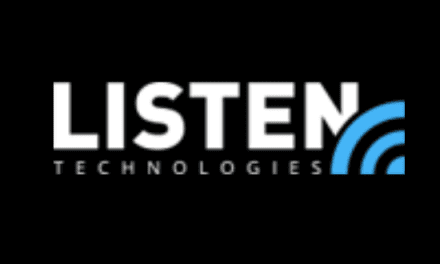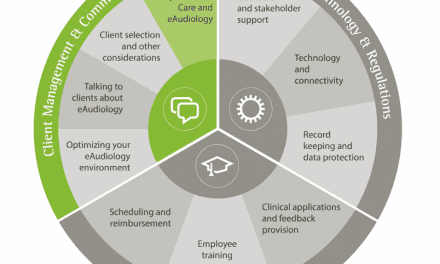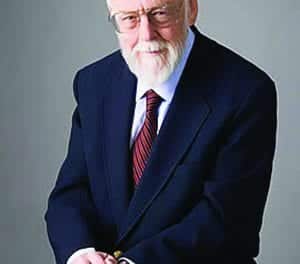Phonak ABCs of eAudiology #6: 10 Steps to Technology & Connectivity for eAudiology
The Phonak ABCs of eAudiology is a handbook of step-by-step guides for incorporating eAudiology and Phonak eSolutions into daily hearing care practice. Each guide has been written by a renowned international expert in this field. A comprehensive range of considerations have been broken down into easy-to-follow steps towards practice implementation. Following the 10 steps in this series of implementation guides could see hearing care professionals up and running with eAudiology services in your practice very soon, benefiting from improved workflows and cost savings, providing your clients quality care in a way which is most convenient to them.
Getting your practice up to speed to offer eAudiology services takes a little work on the front end before you begin to offer these exciting, new services to your clients. Just a few preliminary steps can drastically cut down on troubleshooting and technical issues during the eAudiology appointment. This will build your confidence offering eAudiology services, and result in a positive experience for your clients. Let’s get started!
Where to start?
Step 1
Test your Internet speed. There are many free sites online that will tell you the upload (Mbit/s), download (Mbit/s), and ping. I personally like and use https://www.speedtest.net/, but a quick Google search will give you many options! If you are unsure what Internet speed is needed to support an eAudiology solution, contact the manufacturer to ask.
Step 2
If your Internet speed is poor, don’t give up! There are a couple of options if you find your Internet speed does not meet the recommended minimum speed to provide eAudiology services:
- Call your Internet provider to inquire about upgrading your contract to a higher speed.
- Using a mobile hotspot on your fitting computer.
If the cellular network which the mobile hotspot taps into is strong enough, this can work as a “Plan B.” Of course, you will want to test the speed as described in Step 1. A good Internet or Wi-Fi connection will always be the most stable solution, but this is another option.
Step 3
Make sure you have the required equipment to use eAudiology services. This could include items such as a webcam, headset, etc.
Step 4
Make sure you know which hearing aids are compatible with the eAudiology service you are adopting.
Step 5
Have the link handy to check if your client’s smartphone is compatible: https://marvel-support.phonak.com/en/audeo-m-cell-phone-compatibility/
Step 6
Test the solution with a colleague before using it for the first time with a client. You don’t want to get caught in an uncomfortable situation due to lack of experience. Like anything else new, offering eAudiology services is easiest if you give yourself the chance to practice first and become familiar with the process.
Step 7
Ensure the client is a candidate for an eAudiology session from a technological and connectivity standpoint. Ask if the client has Internet at home, do they know how to download apps, do they have an email address, etc. Tools exist to help you identify ideal candidates, like the Client Profiling tool, which you can download on the Phonak eAudiology webpage.
Step 8
Make sure the client has new batteries in their hearing aids. Sometimes clients may not be able to remember exactly when they last changed the batteries, so I ask the client to change the batteries before the eAudiology session. This is one less thing to worry about should a technical issue arise during the session. Troubleshooting is often a process of elimination, and this is one thing you can eliminate right from the start!
Step 9
Make sure the client’s smartphone is fully charged. Starting an eAudiology session with a low battery can lead to a poor outcome. Ask the client in advance to be prepared with a charged smartphone.
Step 10
Not every client is a candidate for eAudiology services. When providing eAudiology services one thing is sure; there will be circumstances out of your control. This might be Internet speed, or other issues which are unknown. This feeling isn’t comfortable, but experience will help you to determine what issues you can troubleshoot, and what issues are not in your control. For example, if a client has poor Wi-Fi at home, or a smartphone that is not compatible, then they are simply not a candidate for eAudiology services at the moment.
To download a PDF of the article, please click here: 10 Steps to Technology & Connectivity for eAudiology
Are you up to the challenge?
Do you already know the speed of your clinic’s Internet or Wi-Fi? What about the cellular signal on your smartphone in the clinic? As a first step, test these to see if you are ready to start providing eAudiology services (Phonak recommends 5 Mbit/s upload and download speed). If you are using Wi-Fi, test at different locations throughout the clinic. If you are using a mobile hotspot, are there rooms where the speed is faster or slower depending on infrastructure, such as windows?
Other Articles in the Phonak ABCs of eAudiology series below:
| 1. | Licensure and Stakeholder Support | William Campbell |
| 2. | Optimizing Your eAudiology Environment | Danielle Glista, PhD |
| 3. | Clinical Applications and Feedback Provision | Gurjit Singh, PhD |
| 4. | Employee Training | Karen Muñoz, EdD |
| 5. | Scheduling and Reimbursement | Rachel Higginbotham, AuD |
| 6. | Technology and Connectivity | Jean Anne Schnittker, AuD |
| 7. | Talking to Clients about eAudiology | Gina Angley, AuD |
| 8. | Client Selection and Other Considerations | Evelyn Davies-Venn, PhD |
| 9. | Family-centered Care and eAudiology | Joseph Montano, EdD |
| 10. | Record Keeping and Data Protection | William Campbell |

began working at Phonak US in 2005 and moved to Switzerland in 2011 to work at Sonova as a research audiologist on the Science & Technology team. Her focus is researching various eAudiology applications, with a special emphasis on remote fitting. She is also a member of the Sonova Hear the World Board. Jean Anne holds a Master of Science in Audiology from Purdue University (2003), and a Doctor of Audiology from University of Florida (2008).





